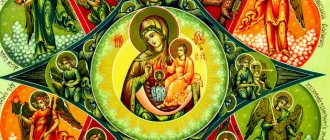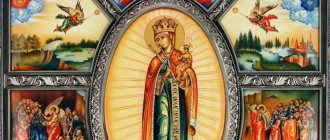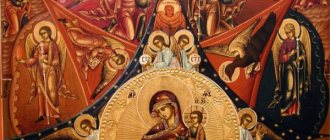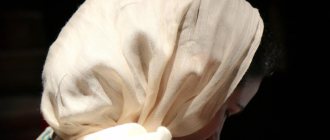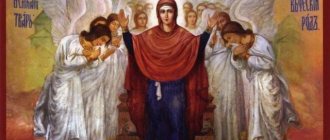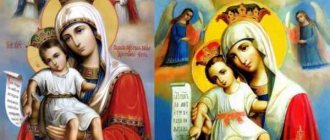Full version of the site -> Mobile version
Today on the calendar: Holidays and events
Events that occurred on July 24 in the world, in various years.
Folk calendar
Efimya Stozharnitsa.
Olga Stradnitsa... Orthodox calendar
of the Great Martyr Euphemia All-Praised.
Equal to the Apostles Grand Duchess Olga of Russia, in holy baptism Helena. St. Arkady of Vyazemsky, Novotorzhsky... Holidays and memorable days of Russia
Holidays are expected: 07.26.2021 - Parachutist Day. 07/28/2021 - Day of the Baptism of Rus'. PR Specialist Day. 08/01/2021 - Logistics Day of the Armed Forces of the Russian Federation. Collector's Day.
All the holidays...
A calendar is a system for counting long periods of time, based on the periodicity of such natural phenomena as the change of day and night, the change of phases of the Moon, and the change of seasons.
Calendar - (from Latin calendae or kalendae, “calends” - the name of the first day of the month among the ancient Romans), a way of dividing the year into convenient periodic time intervals. The main tasks of the calendar are: a) fixing dates and b) measuring time intervals.
The first calendars arose a long time ago, in ancient times, because there was a need to measure time. The word calendar comes from the Latin words caleo - to proclaim and calendarium - debt book. In Ancient Rome, debtors paid interest on the day of the calendar, the first days of the month) - a number system for large periods of time based on the periodicity of the movement of celestial bodies: the Sun - in solar calendars, the Moon - in lunar calendars, and at the same time both the Sun and Moon in lunisolar calendars .
The calendar allows you to record historical and social events in their chronological sequence. One of the important tasks of the calendar is to determine the moments of church events, moving and non-moving holidays (for example, Easter).
There are three main types of calendars: 1) lunar, 2) solar and 3) lunisolar.
1. Lunar calendar, which is based on a synodic lunar month with a duration of 29.5 average solar days. Originated over 30,000 years ago. The lunar year of the calendar contains 354 (355) days (11.25 days shorter than the solar one) and is divided into 12 months of 30 (odd) and 29 (even) days each (Muslim, Turkish, etc.). The lunar calendar is adopted as a religious and state calendar in the Muslim states of Afghanistan, Iraq, Iran, Pakistan, the United Arab Republic and others. Solar and lunisolar calendars are used in parallel for planning and regulating economic activities.
2. Solar calendar, which is based on the tropical year. Originated over 6000 years ago. Currently accepted as the world calendar. For example, the “old style” Julian solar calendar contains 365.25 days. Developed by the Alexandrian astronomer Sosigenes, introduced by Emperor Julius Caesar in Ancient Rome in 46 BC and then spread throughout the world. In Rus' it was adopted in 988 NE. In the Julian calendar, the length of the year is determined to be 365.25 days; three “simple” years have 365 days each, one leap year has 366 days. There are 12 months in a year of 30 and 31 days each (except February). The Julian year lags behind the tropical year by 11 minutes 13.9 seconds per year. The error per day accumulated over 128.2 years. Over 1500 years of its use, an error of 10 days has accumulated. In the "new style" Gregorian solar calendar, the length of the year is 365.242500 days (26 seconds longer than the tropical year). In 1582, the Julian calendar, by order of Pope Gregory XIII, was reformed in accordance with the project of the Italian mathematician Luigi Lilio Garalli (1520-1576). The counting of days was moved forward by 10 days and it was agreed that every century that is not divisible by 4 without a remainder: 1700, 1800, 1900, 2100, etc. should not be considered a leap year. This corrects an error of 3 days every 400 years. An error of 1 day “accumulates” in 3323 years. New centuries and millennia begin on January 1 of the “first” year of a given century and millennium: thus, the 21st century and the 3rd millennium AD (AD) began on January 1, 2001 according to the Gregorian calendar. In our country, before the revolution, the “old style” Julian calendar was used, the error of which by 1917 was 13 days. On February 14, 1918, the world-accepted “new style” Gregorian calendar was introduced in the country and all dates moved forward 13 days. The difference between the old and new styles is 11 days in the 18th century, 12 days in the 19th century, and 13 days in the 20th century - lasting until 2100. The solar calendar is usually based on four main dates - two equinoxes and two solstices. The accuracy of a calendar is determined by how accurately the equinox falls on the same day each year. The lunisolar calendar is an attempt to harmonize the length of the lunar month and the solar (tropical) year through periodic adjustments. To ensure that the average number of days per year according to the lunar calendar corresponds to the solar year, a thirteenth lunar month is added every 2 or 3 years. This trick is required to ensure that the growing seasons fall on the same dates each year.
3. Lunisolar calendar, in which the movement of the Moon is coordinated with the annual movement of the Sun. The year consists of 12 lunar months of 29 and 30 days each, to which “leap” years containing an additional 13th month are periodically added to take into account the movement of the Sun. As a result, “simple” years last 353, 354, 355 days, and “leap” years last 383, 384 or 385 days. It arose at the beginning of the 1st millennium BC and was used in Ancient China, India, Babylon, Judea, Greece, and Rome. Currently adopted in Israel (the beginning of the year falls on different days between September 6 and October 5) and is used, along with the state one, in the countries of Southeast Asia (Vietnam, China, etc.).
Next: History of calendars...
The miraculous image of the Holy: what helps and its meaning
Since ancient times, Christians have come to pray to the Queen of Heaven to help resolve difficult life situations.
But how exactly can this shrine help a person? If we take into account the rich history of this image, we can say that the Mother of God the Burning Bush helps with such difficulties:
- During the war period, commanders and soldiers also appealed to the divine scroll in order to ask for protection in battle;
- In particular, the image can help and protect a person if his specialty is a firefighter, doctor, military man or pilot, because people with such a profession, when turning to the image, have always been under the special protection of the Mother of God, protecting the believer so that he does not receive a burn, various injuries, and also The Saint also protects from rash actions;
- Many Orthodox Christians are convinced that this miraculous fire can also save from committed sins;
- The Burning Bush Icon of the Mother of God also helps sick people who pray for deliverance from mental conditions;
- The image of the Intercessor is also used as a talisman to protect the house from various misfortunes;
- At the shrine of the Pochaev Mother of God, the Burning Bush, those born from September 24 to October 23 can find protection. They will also be protected by Saint Sergius of Radonezh, and those who were born from May 21st to June 21st can ask for help from the image of the Heavenly Queen Kupina and Vladimir, Saints Constantine and Alexei of Moscow will protect them.
The best article for you, go to: What does the Icon of the Martyr Matrona of Thessalonica help with?
The very meaning of the icon of the Mother of God of the Burning Bush lies in the iconography of the image, which is set out in some detail. In such a hypostasis, the face of the Virgin Mary is very diverse and has a huge number of varieties of this image, but the most favorite is the one on which there are many images and symbols, which, when fully read, reveal a truly incredible generalization of the meaning of the Most Holy One and her maternal feat for all believers and of all humanity.
Celebration day
Celebrations in honor of the wondrous image take place twice a year:
- September 17 (September 4, old style). On this day, the church honors the memory of the prophet Moses and Kupina;
- On the week of the blind man - the sixth week of Easter. This date is moving. In 2021 it falls on May 13th. In 2021 – June 2. In 2021 – May 24. In spiritual terms, people can be called blind. Humanity moves as if by touch with the help of the Most Pure One.
In churches that are consecrated in honor of this image of the Mother of God, the patronal feast is celebrated on the indicated dates. These days, especially many Orthodox people and priests come to the temple.
Celebrations in honor of the wondrous image take place twice a year.
Bible story
Rice.
1. The image of the Mother of God in this icon is presented to us in the form of a burning bush of the “Burning Bush”, which was revealed to the prophet Moses. From the Old Testament book “Exodus” we know that this miracle happened at a time when the Israelite people were in Egyptian slavery. Moses, tending his sheep, led them to a deserted place to Mount Horeb (now Sinai). An angel of God was revealed to Moses, who was in a thorn bush. This bush burned, but did not burn out. As Moses approached him, he suddenly heard the voice of the Lord commanding him not to come close and to take off his shoes, because this place was Holy. In this conversation with Moses, the Lord revealed to him his destiny to free the Israelite people from Egyptian oppression. Moses was awarded from the Lord the gift of prophecy and miracles.
Rice. 2. The Monastery of St. Catherine is one of the most ancient Christian monasteries, which has never been closed during its entire existence. It was built in the 4th century on the island of Sinai at the foot of Mount Sinai (Horeb in the Bible).
The place where the Lord appeared to Moses is amazing. Now there is the Monastery of St. Catherine, founded in the 4th century. There Greek Orthodox monks carry out their monastic feat.
Rice. 3. The same Burning Bush that appeared to Moses grows on the territory of the monastery. This bush is one of a kind; they tried to plant shoots from it, but it didn’t work out.
In 324, Saint Helena, the mother of Constantine the Great, ordered the construction of a chapel on this site. The altar part of the monastery's cathedral is located on the site where Kupina grows. And behind it is the Chapel of the Burning Bush. The bush itself was transplanted to another place, not far from the Chapel, where it still grows. The chapel was built without an iconostasis specifically so that believers could see the place where Kupina grew. Visitors to the chapel always remove their shoes, following the words of the Lord addressed to Moses:
“Take off the sandals from your feet, for the place on which you stand is the Holy Land.”
Exodus 3:5
The chapel was consecrated in honor of the Feast of the Annunciation of the Blessed Virgin Mary.
Rice. 4. The day of special veneration of the Burning Bush icon is September 17, according to the new style. On this day we also remember the miracle of the appearance of the Burning Bush to Moses.
Questions for the priest
How many times a week should you go to church?
My friend says that two trips are enough, and my mother claims that at least five. I would like to know the authoritative opinion of the holy father. In fact, it doesn’t matter how many times you go to church. Even the word “need” is not appropriate here. People visit church not “for show,” but because of the call of the soul. We all need the Lord, so we go to His House for support. There we find everything our soul needs. Therefore, go only as much as you think is necessary. Your campaign should be sincere and sincere. Remember this.
Can I pray using a photo? Now I am in a place where there is no opportunity to pray to the consecrated image. Will my decision be regarded as blasphemy?
And yet prayer loves consecrated images. In this way, the connection with the Heavenly Kingdom becomes stronger, and prayers become more reliable. Icons primarily help to visualize the image of a saint or the Most High. However, let us remember ancient times, when prayers were offered without icons. In other words, no one forbids you to pray from a photograph if you really believe in the Creator.
I want to baptize my child. He is one and a half years old. Tell me, when should I go to church?
If you want to introduce your child to Orthodoxy, then the time has already come. You can contact the priest of the nearest church and ask him to perform the sacrament of baptism. He will not refuse your request, but you will need to make a donation. Its size is determined independently. Since the child cannot yet bear responsibility for his actions, baptism takes place without confession.
Is it worth baptizing a child yourself?
Definitely not! The rite of baptism can only be performed by the holy father. Firstly, he knows how to perform the ceremony correctly. And secondly, he is close to the Almighty. You will only make things worse or incur punishment for sacrilege. You should not do this, even if you are sure that everything will go smoothly. Contact the church, ask the clergyman for this service, and only in this case will baptism be carried out according to the rules of the church.
Miracles of the Burning Bush Icon
There are many known miracles that the divine image performed. 1390 is considered the year of the first mention of the magical and miraculous power of the Kupina icon. The shrine was brought to Russia from Palestine.
- Once, the equerry of the Russian Tsar Fyodor III Alekseevich was saved by the Burning Bush shrine when he fell into disgrace. Dmitry Koloshin believed in the power of prayer to the sacred image.
- The answer to his prayers was the appearance of the Mother of God to the king in a dream, and she said that the groom was innocent. The king studied the case again and acquitted the defendant. For the freedom granted by the Mother of God, Dmitry built a temple with his own money and named it in honor of the Burning Bush.
- In ancient times, most of the buildings in Moscow were made of wood, which resulted in constant fires. During fires, the icon was taken out of the temple and carried around the buildings.
Works wonders
1822 - time of terrible fires in Slavyansk (Donetsk region). However, the root cause could not be discovered. One day one of the believers had a dream. She was told that in order to prevent fires, she should draw the image of the “Burning Bush”. Upon completion of work on the icon, perform a divine service in the monastery. They painted the icon and to this day they read prayers in front of it and worship it. Just before the next fire, a mentally deprived woman was captured. She was the culprit of all the misfortunes. Immediately after that, everything got better and the fires ended.
A miracle created in the image
Many incredible miracles are associated with this face, for example:
There was a terrible fire that consumed most of the houses and buildings. One of the witnesses said that he saw a crying woman standing in the distance, holding the Holy Image in her hands. The fire continued to spread, but the woman stood motionless. After the fire subsided and only embers remained from the previously standing houses, everyone noticed that one house still managed to survive, and this was exactly the house opposite which the woman stood with a divine face in her hands;
There is one more documented event. At that time, when Napoleon's troops, after the plunder and burning of Moscow, they left the city. A Polish mercenary came to the Novodevichy Convent to the priest Father Alexei Vvedensky, who gave him a rich robe taken from the image of Kupina in one of the churches.
He admitted then that from the time he committed an act of sacrilege, his soul was constantly tormented by an immense melancholy that did not lower him. And he realized that he needed to return the robe to the sacred place and after which he felt an indescribable spiritual relief.
Burning bush. History of the icon
In the 4th century. The icon depicted a burning bush, and inside it was the image of the Mother of God. Most often this image was the Mother of God Hodegetria. This is one of the most common images of the Virgin Mary with the infant Christ, which is believed to have been originally painted by the Evangelist Luke himself. In this image, the Mother of God and Christ do not touch each other’s faces and Jesus is depicted closer to a youth than to infancy. According to many art historians, in this icon the Mother of God and Christ are having a conversation.
We advise you to study the Icon of St. Nicholas the Wonderworker
It was this image of the Burning Bush that was known in Rus'; it was brought to our region by monastic pilgrims. In the VI century. During the reign of Ivan the Terrible, new details appeared on the Burning Bush icon. In those days, Rus' was growing with new lands. It included Siberia, Astrakhan, Kazan... Rus' became the largest world power and one of the centers of Orthodoxy. It was at this time, during the reign of Metropolitan Macarius, that the image was reworked. There, in addition to the plot about the unburning bush, several theological texts are added.
The burning bush becomes an akathist icon. An icon designed to glorify the Virgin Mary. The new idea of the Burning Bush is that the Mother of God gathers the whole world around her - heaven and earth, the elements and forces of nature. Two crossed rhombuses are added to the icon - red and blue or green. We see this combination in the image “Savior in Power.” The crossed rhombuses on this icon spoke about the ideas of ancient people about how our Universe works. The red rhombus symbolizes the earth, and the blue or green one symbolizes the sky; above the sky in the oval are the Heavenly Powers. And above all, of course, is Jesus Christ himself.
On the icon of the Burning Bush, rhombuses receive additional semantic meaning. The red diamond symbolizes the flame, and the green one symbolizes the bush itself, engulfed in flames. Evangelists are depicted in the corners of the red diamond, which gives us a reference to the “Savior in Power” icon. The earthly flame in this icon tries to embrace the Heavenly and is unable to do so. The icon tells us that we can protect ourselves from the flames through faith and prayer. Inside one of the rhombuses are depicted angels who serve the Virgin Mary.
The Burning Bush icon has collected many meanings and has become very difficult to interpret. Change of image in the 6th century. had an important mission. With the annexation of the lands, an important task lay ahead - to show Orthodoxy to the people living on them
It was easier to attract their attention with unusual, complex images. The Burning Bush reflected the greatness and depth of the Orthodox faith
Thus, in the new images, the Mother of God holds different symbolic images in her hands: a ladder, which refers us to the vision of the prophet Jacob, who saw the ladder as an image of the Mother of God in the form of a path from earth to Heaven. Some images contain a mountain or stone as a symbol of exaltation, relief and ascent to Heaven. The ladder of Christian life leads a person to the Kingdom of Heaven, where Christ appears in the image of the King of Heaven. Thus, on the Burning Bush there are two images of Christ - the youth and the King of the heavenly city. Sometimes in the icon of the Burning Bush, the Mother of God holds in her hands the Gate of Ezekiel.
The Monk John of Damascus interpreted the image of the Burning Bush as follows:
Image of the Divine Face
The image itself was drawn from two rhombuses, with edges concave inward, thereby forming an eight-pointed star.
The first rhombus is made in bright red tones, personifying fire, but the second one shows the Mother of God, who remained the same green after the fire. In the central part of the shrine, the Saint is depicted holding her son in her arms and holding a ladder in her right hand. However, in addition to the ladder itself in the hands of the Mother of God in the image, you can also see a wonderful bush.
In this case, the ladder is the personification of the descent of God's son to earth, and near which a mountain was written as a symbol of ascension. At the shrine, you can also see a huge number of angels serving as a symbol of the gifts of the Holy Spirit and the elements, namely: teaching, giving wisdom, working miracles, giving and much more.
Burning Bush - a wonderful icon
On the icon of the Mother of God “The Burning Bush” Her image with her Son is inscribed in an eight-pointed star. This is a fairly late iconographic type; it carries the same symbolism as the icon of the Savior in Powers.
The main recognizable feature of the iconography is the complex symbolic figures that are not found on any other image: images of angels, animals and geometric figures that fill the entire space of the icon. All of them have a special theological meaning and denote different forces and phenomena on the material and spiritual levels. The colors of the figures are taken from biblical texts. In a general sense, their symbolism can be described as Omnipotence, Omniscience, Goodness and Grace, the natural Incomprehensibility and Mystery of God.
• The figure of the Mother of God and Christ (as in the image of the Savior in Powers) is inscribed in a red rhombus or in a red oval with pointed edges stretched lengthwise behind the throne. Next comes a blue oval or round sphere placed in a red square, usually creating some kind of background for the entire composition. • The red diamond around Christ is the radiance of the Divine fire, the reflection of the Divine nature of the Lord. • In the blue field of the circle one can see the outlines or silhouettes of the Heavenly Angelic ranks, that is, the armies of the Heavenly King. It can be seen that they are in motion, creating the dynamics of the iconic composition. Angels are depicted as sexless winged creatures, similar to young men, or simply symbolically - faces with wings. An oval or circle as an endless all-encompassing figure means the spiritual, celestial sphere, the world of disembodied spirits, the vault of heaven. What we see as heaven, the icon shows with visible spiritual vision as a space filled with Angels. Often the icon contains angelic wings with eyes, winged wheels at the foot of the throne and translucent images on the throne - all these are also symbols of the Heavenly Powers, the orders of Angels surrounding God and helping Him. • A red square with elongated ends means earth, which has four elements. At its ends are the symbols of the four evangelists described in the Apocalypse: an angel (Matthew), a calf (Luke), a lion (Mark) and an eagle (John) - carrying the Word of God to all four corners of the world.
The very color scheme of the icon, built on a combination of red and blue, means the unification of the Divine and human, earthly nature of the Savior in Him Alone, the fire of the Holy Spirit and the living water of the teachings of Christ, the unity of the Kingdom of Heaven and the earthly world under God’s authority. Sometimes the Savior’s clothes are also depicted in red and blue.
We remind you, dear Brothers and Sisters, that only we have the largest catalog of icons and photos and you can buy the Burning Bush icon at the lowest price!
Meaning of the image
After the coming of the Savior into the world, this Old Testament image received a new theological interpretation. The Most Pure Virgin Mother of God became such a “Burning Bush” for all of us, having conceived from the Holy Spirit the Lord Himself, who is the Fiery Light for us. The same Unearthly Light illuminated Her Divine Son on the holy Mount Tabor, just as the fireproof thorn bush was once revealed to Moses on Mount Sinai. It was not for nothing that the monastery of St. Catherine was also consecrated in honor of the Transfiguration of the Lord.
The Mother of God lived a long life filled with immaculate purity. She was incombustible by that Divine Fire, about which Metropolitan Anthony of Sourozh once said: “God imparts combustion, but does not feed on matter.” Having accepted the Holy Spirit, She was not touched by His flame, which burns away everything unclean, because the Lord Himself was in Her.
We advise you to study How to be baptized correctly for Orthodox Christians?
Burning bush in nature
The “burning bush” (in the modern concept) is also called dictamnus and ash tree. The scientific name Dictamnus comes from the merger of the Greek words - thamnos - "bush" and the name of one of the Cretan mountains - Dicte. This flower was nicknamed the ash tree for the similarity of its foliage with the leaves of an ash tree, but they began to call it the “burning bush” because of its unusual properties. Its fruits contain large quantities of essential oils, which are released during the period of seed ripening.
Ash plant (burning bush)
Fraxinella
There is information that if you bring a lit match to an ash tree on a hot, sunny, windless day, a flame will break out above it, but the plant itself will remain unharmed in the midst of the fire. This is where the popular name for these plants comes from - “burning bush”. However, the assumption that this plant corresponds to the fireproof “thorn bush” of the Old Testament (Ex. 3:2) is not justified, since the ash tree does not have thorns and therefore, by its nature, does not properly correspond to the Biblical narrative.
Help and prayer before the holy image of the Burning Bush
The holy image is considered a protector from the fire element and robbers. The main purpose is to cleanse sins with the help of fire.
People who are at war, firefighters and police officers pray in front of the icon for healing of soul and body, for help in curing mental illnesses. They also pray for protection from various kinds of barbarity, attacks and robbery.
Sacred
The main thing is sincere prayer and faith, then your request will be heard and a helping hand and support will be extended.
Text
People wonder where in the house to place this Shrine. No specific location has been established. Many broadcast it over the front door, like a holy shroud over the hearth.
Rules of prayer
A prayer appeal to the Mother of God and the saints can be said out loud or silently. They pray to the holy image in church or privately. They light a blessed candle in front of the icon and make the sign of the cross. It is important to distract yourself from current worries and problems so that your soul and thoughts are focused on the words of prayer. They must be pronounced feelingly and sincerely.
Before this, you need to mentally repent before God, remembering your sins. The soul and thoughts must be cleansed of evil and ill will towards anyone. To get yourself into a prayerful mood, priests advise reading the “Our Father” several times before the protective prayer. At the end of the prayer, you must make the sign of the cross and put out the candle.
How to pray
When praying before the icon of the Mother of God, we must remember that everything that happens to us is sent to us by the Lord for our own good. Therefore, first you need to pray to the Lord, ask him for forgiveness for bad deeds, ask for help in what worries you and thank Him for everything. After all, He loves us all, desires our salvation and often sends us trials in life for our own good, so that we turn to Him more often and do not rely only on ourselves and our own strengths.
After praying to the Lord, let us offer our prayers to the Mother of God before Her holy face. You need to pray using the text of church prayers and in your own words. When reading the text of the prayer, you need to pass every word through your mind and heart.
Rice. 8. When praying in your own words, you need to think about what worries your soul most and sincerely ask for help and intercession from the Lord and the Mother of God.
When praying in front of the Burning Bush icon, you need to use the following text:
Prayer 1
“To the Queen of Heaven, our Lady, Lady of the Universe, Most Holy Theotokos, undefiled, unglamorous, imperishable, most pure, pure Ever-Virgin, Mary Bride of God, Mother of the Creator of creation, Lord of glory and Lord of all! Through you the King of kings and Lord of lords has come and appeared to us on earth. You are God's mercy incarnate. You are the Mother of Light and Life, just as you once carried Him in Your womb and in Your arms You had the Child, the Word of the Eternal, God, and so you have always carried Him with You. For this reason, according to God, we resort to You, as if to an unbreakable wall and intercession: look with mercy, O all-sung Mother of God, on our fierce anger and heal our souls and bodies of illness: drive away from us every enemy and adversary, deliver from famine, pestilence, from plagues, from many waters and harmful airs, and from sudden death; and like the three youths in the cave of Babylon, preserve and keep us, so that, like the people of God of old, all good things will come to us who honor Thee; Let all those who hate us be ashamed and put to shame, and everyone will understand that the Lord is with You, O Lady, and God is with You. In the days of autumn, bring us the light of Thy grace, and in the darkness of the night, enlighten us with light from above, making everyone useful: turn our sorrow into sweetness and wipe the tears of Thy servants who have sinned and are in need, fulfilling all their requests for good; You can do everything you want, Mother of the Word and Life. The Father has crowned the Daughter, the Son has crowned the Virgin Mother, the Holy Spirit has crowned the Bride, so that you may reign like a queen, standing at the right hand of the Holy Trinity, and have mercy on us as you wish, now and ever and unto ages of ages. Amen".
Prayer 2
“Oh, Most Holy and Most Blessed Mother of our Sweetest Lord Jesus Christ! We fall down and worship You before Your holy and most honorable icon, with which You have performed wondrous and glorious miracles, saving our homes from fiery flames and lightning thunder, healing the sick, and fulfilling every good request of ours for the good. We humbly pray to You, O omnipotent Intercessor of our race, to grant us the weak and sinners Your maternal participation and care. Save and preserve, O Lady, under the shelter of Your mercy, the Holy Church, this monastery, our entire Orthodox country, and all of us who fall before You with faith and love, and tenderly ask with tears for Your intercession. She, the All-Merciful Lady, have mercy on us, overwhelmed by many sins and not having boldness towards Christ the Lord, ask Him for mercy and forgiveness, but we offer to You for supplication His Mother in the flesh: But You, All-Good One, stretch out Your God-receiving hand to Him and intercede for us before His Goodness, asking us for forgiveness of our sins, a pious, peaceful life, a good Christian death, and a good answer at His terrible Judgment. At the hour of the terrible visitation of God, when our houses are set on fire, or we are frightened by lightning thunder, show us your merciful intercession and sovereign help: may we be saved by your omnipotent prayers to the Lord, the temporary punishment of God here, and we will inherit the eternal bliss of paradise there: and with everyone let us sing to the saints the Most Honorable and Magnificent Name of the worshiped Trinity, the Father and the Son and the Holy Spirit, and Your great mercy to us, forever and ever. Amen".
We advise you to study Why do the Apostle Peter have the keys to heaven?
Briefly about the icon of the Mother of God “The Burning Bush”
This is one of the oldest Old Testament images of the Virgin Mary. The composition of the icon is full of symbolism and allegories and refers us to the biblical story of Moses. The Old Testament prophet was tending sheep when the Lord appeared to him in the form of a burning thorn bush. This bush was named Burning Bush. Iconographic theological thought clothed the Mother of God in this image. Just as a bush burned and did not burn, so the Mother of God eternally remains a Virgin: before Christmas, after Christmas and after Christmas she remains Most Pure. The Holy Spirit, who became Christ in Her, did not scorch Her with His Divine light - She turned out to be untouched and lived in immaculate purity until the end of her days.
Spreading the image
There are two iconographic schemes for this image. The first is a half-length image of the Virgin Mary (Oranta type) inside a bush engulfed in flames and Moses kneeling in front of her. This scheme became widespread in the early centuries of Christianity, but in the 16th century it was replaced by a more complex composition - the Mother of God and the Infant began to be depicted in the center of an octagonal star composed of two quadrangles.
The colors of the squares are red and green, in a colorful analogy with flames and thorn leaves. In the hands of the Most Pure Virgin is a ladder, the prototype of which is She herself, for She is the path to heaven (in this form the holy Patriarch Jacob saw Her). In other variations of this version, a stone or mountain is added to the ladder - a symbol of easier ascent to heaven.
In the elongated rays of an eight-pointed star are images of angels and archangels with attributes personifying their hypostases: a lantern, a rod, a censer, a sword, a cup. In the apocalyptic image of animals, a lion, an eagle, a calf and an angel, the evangelists are represented: Mark, John, Luke and Matthew.
The number of disembodied spirits varies according to the will of the icon painter and the design of the composition. The presence of heavenly forces reveals the theme of serving the Mother of God and worshiping the fact of the immaculate conception of the entire angelic host. Being the center of the iconographic scheme, the Mother of God symbolizes the Church-Sophia - the Wisdom of God, concentrating around itself the forces of earth and heaven.
Burning Bush, icon of the Mother of GodMiddle of the 16th century; From the Church of Our Lady Hodegetria in RostovWood, gesso, tempera; height 118 cm, width 89 cm In the center of the icon is a half-length image of the Mother of God with the Child in glory. In the corners of the red rhombus there are images of four apocalyptic creatures. Images of heavenly powers are located in the corners of the green rhombus of glory, as well as in multi-colored segments of ovals with wavy edges inscribed between the corners of the rhombuses. In the four corners of the icon, in the margins, the visions of the Old Testament prophets Moses, Isaiah, Ezekiel and Jacob are presented. State Rostov-Yaroslavl Architectural and Art Museum-Reserve.
The Monk John of Damascus interpreted the image of the Burning Bush as follows:
